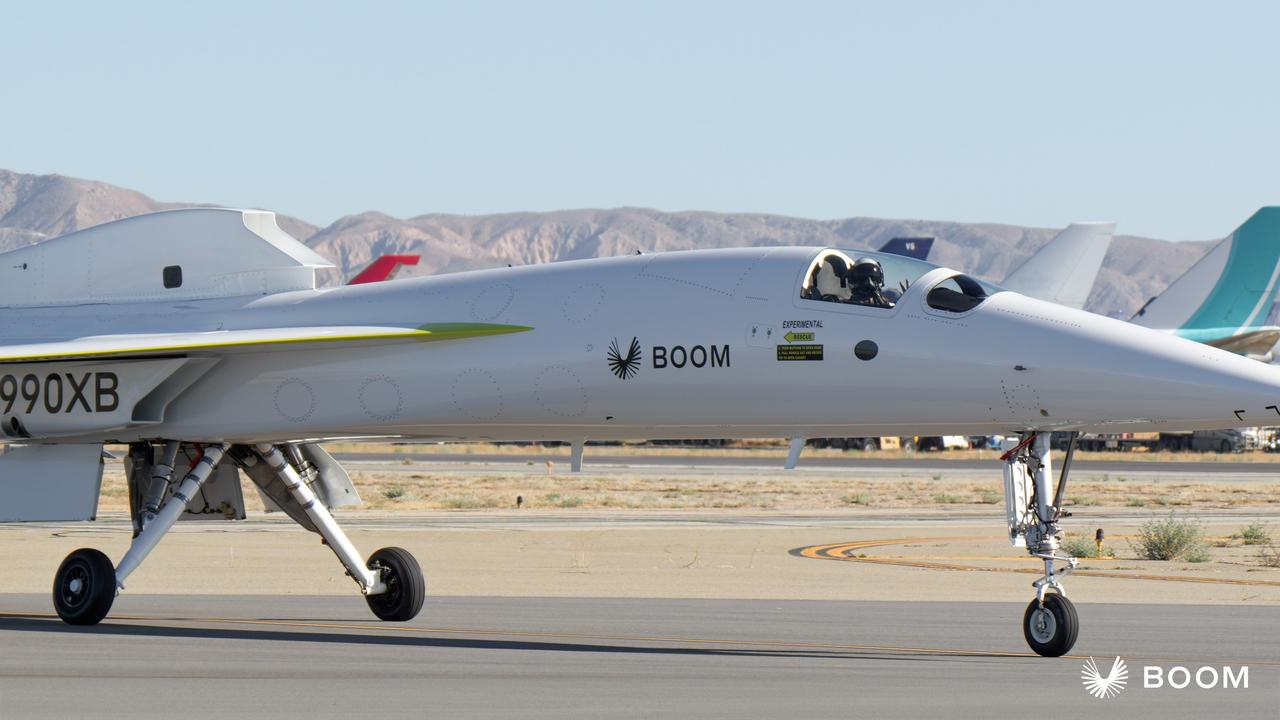New supersonic plane designed to fly Melbourne to LA in 8.5 hours
There is a new aircraft being designed to be able to fly from Melbourne to LA in just 8.5 hours – and it could be here sooner than you think.

An American company designing a new aircraft with the ability to fly from Melbourne to Los Angeles in just 8.5 hours is expected to start flying its first passengers within six years.
Colorado-based company Boom is developing a commercial supersonic aircraft called Overture and already has orders from three airlines.
Boom tells news.com.au Australians on-board Overture would be able to travel to international destinations in almost half the time.
This includes Melbourne to Los Angeles in just over 8.5 hours instead of almost 14 hours, Brisbane to Shanghai in five hours instead of 10 hours, and Melbourne to Kuala Lumpur in less than five hours instead of eight hours.

Commercial supersonic flight has been on hiatus since Concorde was retired two decades ago after 27 years of flying. The last commercial Concorde flight landed in Bristol, England in 2003.
Paul McCartney, Michael Jackson and Queen Elizabeth II were among the famous faces who flew on Concorde flights.
Musician Phil Collins famously performed at the 1985 Live Aid charity concerts in London and Philadelphia in the US on the same day thanks to Concorde.
But the plan for Overture is for supersonic commercial flights to be a lot less exclusive.

While news.com.au was told no Australian airlines have yet placed an order, airlines that fly Down Under have.
Japan Airlines pre-ordered 20 aircraft in 2017 and United Airlines ordered 15, with an option for 35 more, in 2021.
United will become the largest carrier between the US and Brisbane, Sydney and Melbourne this year, as part of “the largest South Pacific expansion in aviation history by any airline”.

American Airlines was the latest airline to order Overture aircraft, placing a deposit on up to 20 aircraft, with an option for 40 more, in August last year.
That means orders and pre-orders for Overture currently stand at 130 aircraft.
“Global airlines have been very receptive to Overture, given the advantage of supersonic on transoceanic flights,” Boom told news.com.au when asked about Australia’s interest.

The company’s current target timeline is to roll out the aircraft in 2026 and have their first flight in 2027.
Boom expects to get type certification in 2029, which would allow Overture to carry its first passengers.
“Construction on our final assembly line, called the Overture Superfactory, is well underway and anticipated to be complete next year,” Boom said.
Overture is designed to run off sustainable aviation fuel (SAF) and carry between 64 and 80 passengers at a speed of Mach 1.7 and altitude of 60,000 feet.
Boom’s piloted test aircraft XB-1, which the company says is the world’s first independently developed supersonic jet, underwent taxi testing this week and is expected to undergo its first flight this year.
Boom said XB-1 had received an experimental airworthiness certificate from the Federal Aviation Administration, secured letters of authorisation to allow pilots Bill Shoemaker and Tristan Brandenburg to fly it, and letters of agreement with airspace authorities allowing flights over the Mojave Desert.

NASA’s supersonic hydrogen jet
Meanwhile, NASA has revealed new updates on its supersonic hydrogen plane that aims to be twice as fast as Concorde.
The US space agency has been researching the possibility of a Mach 4 passenger jet that only takes 1.5 hours to get from New York to London, The Sun reports.
If the plane was to achieve that flight it would be four times faster than what’s currently possible with commercial aircraft.
It would also break Concorde’s record as the plane famously took 2 hours 52 minutes and 59 seconds to complete the New York to London flight in 1996.

NASA said this week: “Flying from New York City to London up to four times faster than what’s currently possible may sound like a far-off dream, but NASA is exploring whether the commercial market could support travel at such speeds.”
The US space agency revealed that it’s identified a possible passenger market and 50 routes for the jet.
It said: “The NASA studies concluded potential passenger markets exist in about 50 established routes that connect cities.
“Since the US and other nations prohibit supersonic flight over land, the studies’ findings covered transoceanic travel, including high-volume North Atlantic routes and those crossing the Pacific.”
For the plane to be a commercial success, overland supersonic flight rules would need to be changed.

NASA intends to conduct more research into air travel possibilities to make commercial flights travelling between Mach 2 and Mach 4 speeds a reality.
That translates to about 2,470 to 4,940 km/h at sea level.
Boeing is also involved in the project and will be leading a team as well as other big brands like Rolls-Royce and GE Aerospace.
NASA added: “Each team will develop road map elements to include airframe, power, propulsion, thermal management, and composite materials that can hold up under high-supersonic speeds.
“They will also create non-proprietary designs for concept vehicles.”
Mary Jo Long-Davis, manager of NASA’s Hypersonic Technology Project said: “The design concepts and technology road maps are really important to have in our hands when the companies are finished.
“We are also collectively conscious of the need to account for safety, efficiency, economic, and societal considerations. It’s important to innovate responsibly so we return benefits to travellers and do no harm to the environment.”
– with The Sun






